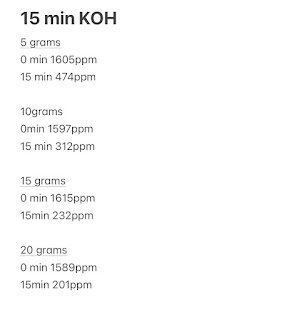Ingrid's Day 11 Sr.Project
Ingrid Wu's Day 11 Blog
May 19 2023
Traditional CCS desorption efficiency
Increased CCS efficiency using direct precipitation should be considered through checking the CO2 desorption efficiency calculation formula as below. Listed below are the CO2 Desorption rates for traditional methods and single process carbon capture, which show that adsorption of carbon dioxide by a single process is more efficient, especially when carbon is left in the solution 10 times less than it was with a traditional process (Murnandari, 2016).
The traditional thermal treatment approach after the precious amine-scrubbing process is usually performed by heating the amine solution under the temperature 90-120 °C. In Eqs.4., the rich and lean amine loading is taken from the reheated amine solution at 90 °C. In the trial of alternative mineralization CCS, Murnandari et al. (2016) tested the regenerating procedure of thermal treatment, lean amine loading is lacking in order to perform a complete calculation of CO2 desorption rate. According to the calculation process provided in Eqs. 4., it turns out that the lean amine loading is 0.077 mol CO2 per mol of amine solution (by setting the initial lean amine loading as a variable X and plugging the X in the equation to start the computation). The significance of this number can be determined through the comparison of rich amine loading and lean amine loading of the single process mineralization of CO2 illustrated by Murnandari et al. (2017) (Murnandari, 2017).
The reason to overturn the thermal amine regeneration is that the energy penalty for the traditional amine scrubbing is too high to make the carbon capture process useful. Based on the practical cases, the energy penalty values for 100% capture amounted to 48.6% for liquefied and 43.5% for compressed (Page et al., 2009). Almost half of the energy spent on heat emphasizes that an improved cost-effective system needs to be developed. The high electricity output also contributes to the release of CO2 into the atmosphere.
The application of Calcium Hydroxide in CCS
The data obtained from the document of Kang et al. (2017) comes from calculating the direct precipitation of carbon dioxide by introducing Ca(OH)2 at 40 °C. Different from testing the efficiency of various amine absorbents conducting thermal regeneration, Ca(OH)2 is added to the solution to test the conversion rate of CO2 to CaCO3 by weighing the mass of CaCO3.
After CaCO3 forms in the amine solution, the CaCO3 would be collected and dried in an oven at 60 ℃ for one day. Ca(OH)2 would be added twice into the amine solution to promote the conversion, and the CaCO3 would also be collected twice. The dried CaCO3 mass then would be calculated to get the percentage of 97.4% (CO2 desorption rate). The 97.4% conversion rate through this process is extraordinary, especially when the required temperature for the Ca(OH)2 carbon capture process is only 40 °C and 60 °C for oven drying compared to 90 °C in the traditional thermal regeneration (Kang, 2017).
The lower temperature needed for the regeneration after adding Ca(OH)2 is because of Le Châtelier's principle: whenever a dynamic equilibrium is disturbed by a change in conditions, including heat, the equilibrium position shifts to compensate for the change (Libretexts, 2020). According to the Ca(OH)2 solubility experiment done by Saipullaev et al. (2020), an increase in the temperature of a supersaturated Ca(OH)2 solution will decrease the activity of OH– ions, shown in Table 2. The higher temperature hinders the solubility of the Ca(OH)2, and the additional higher temperature will in turn shift the solubility of Ca(OH)2 (Saipullaev et al., 2020). As a result, a lower temperature may maintain the solubility of Ca(OH)2 in the solution to an equilibrium rate to save heating costs. This characteristic of Ca(OH)2 may benefit the CCS process and should be used widely as it does not require a high temperature for thermal regeneration and does decrease the frequency of amine regeneration for its high amine loading level (Murnandari et al., 2017) (Kang et al., 2018).
Total Hour: 77h
Work Hour: 6.5h




Comments
Post a Comment